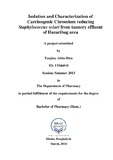| dc.contributor.advisor | Rajib, Samiul Alam | |
| dc.contributor.author | Hira, Tanjina Afrin | |
| dc.date.accessioned | 2018-12-04T06:04:18Z | |
| dc.date.available | 2018-12-04T06:04:18Z | |
| dc.date.copyright | 2018 | |
| dc.date.issued | 2018-03 | |
| dc.identifier.other | ID 13346010 | |
| dc.identifier.uri | http://hdl.handle.net/10361/10955 | |
| dc.description | This project report is submitted in partial fulfilment of the requirements for the degree of Bachelor of Pharmacy, 2018. | en_US |
| dc.description | Catalogued from PDF version of project report. | |
| dc.description | Includes bibliographical references (page 43-49). | |
| dc.description.abstract | Hexavalent Chromium is referred as a highly poisonous metal for the natural environment which plays a role of cancer causing agent for the human. It causes different types of cancer and toxicity like skin cancer, lung cancer, pulmonary congestion etc. Moreover, its concentration is increasing day by day due to the untreated effluent from different industries. The purpose of this study was to identify the bacterial strain that are resistant to hexavalent chromium and has the capacity to convert the hexavalent chromium into trivalent chromium. To accomplish this purpose, sample was collected from the Buriganga River near the Hazaribag tannery and was purified and isolated using different parameters and protocol. Then the isolated strain was studied to explore their capacity to reduce the hexavalent chromium. The outcome was that the strain is resistant to hexavalent chromium as well as it has chromium reduction capacity which varies depending on the temperature and pH. That strain has worked efficiently at 37̊C, pH 5.5 rather than the other temperature and pH. In addition, Antibiotic resistance profile was also examined and it is found that they cannot resist the effect of certain antibiotics. However, they became resistant to penicillin, azithromycin and some other antibiotics. Minimum Inhibitory Concentration was also examined to see their tolerance level at different chromium concentrations which shows that it can tolerate up to 5Mm of chromium concentration. Moreover, BLAST was performed for the strain which shows maximum similarity with the strain Staphylococcus sciuri. To ensure the findings, a phylogenetic tree was created which also shows resemblance with Staphylococcus sciuri with the experimental strain.
Cr (VI) is a hazardous metal for the environment which is polluting water and soil as they are discharged untreated to the environment. It becomes a necessity to abolish them to preserve the natural environment. Through this study, bacterial strain which has chromium reduction capacity will be identified with their chromium tolerance level so that they can play a role in the reduction of poisonous hexavalent chromium from the earth. | en_US |
| dc.description.statementofresponsibility | Tanjina Afrin Hira | |
| dc.format.extent | 49 pages | |
| dc.language.iso | en | en_US |
| dc.publisher | BRAC University | en_US |
| dc.rights | BRAC University project reports are protected by copyright. They may be viewed from this source for any purpose, but reproduction or distribution in any format is prohibited without written permission. | |
| dc.subject | Tannery effluent | en_US |
| dc.subject | Hazaribag | en_US |
| dc.subject | Staphylococcus sciuri | en_US |
| dc.subject.lcsh | Tanneries--Environmental aspects. | |
| dc.title | Isolation and characterization of carcinogenic chromium reducing staphylococcus sciuri from tannery effluent of Hazaribag area | en_US |
| dc.type | Project report | en_US |
| dc.contributor.department | Department of Pharmacy, BRAC University | |
| dc.description.degree | B. Pharmacy | |

